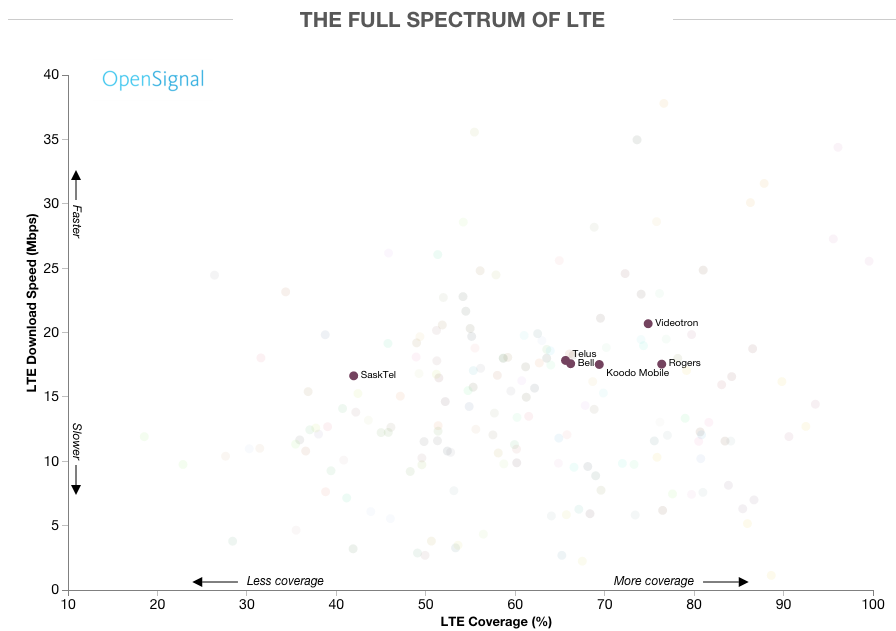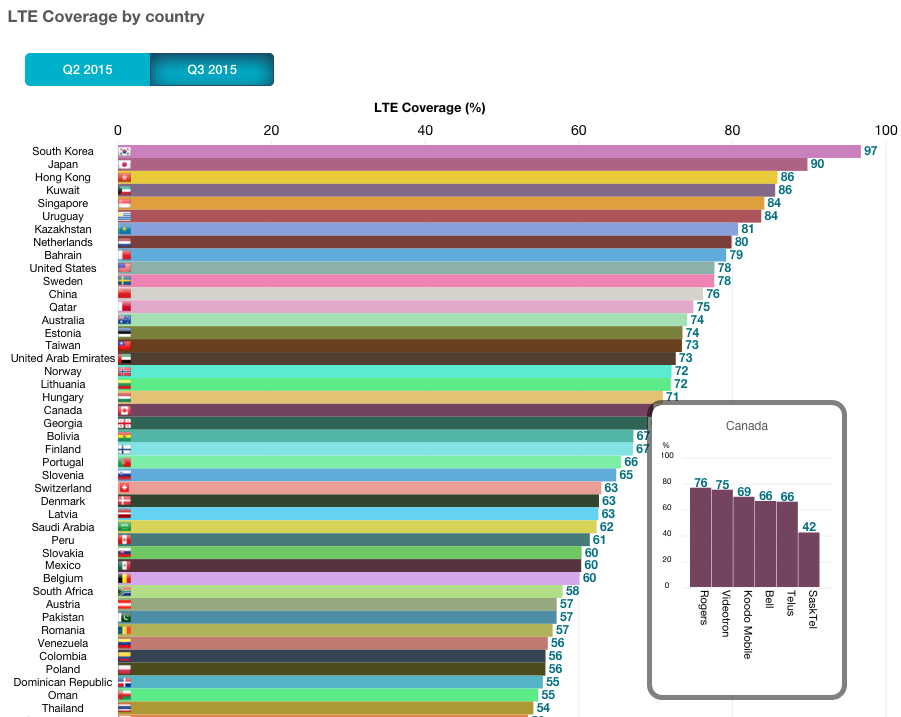
Canada’s LTE networks are not improving as quickly as many of their U.S., European and Asian counterparts, especially when it comes to national coverage, according to a new quarterly reported issued by independent analytics firm, OpenSignal.
The company included five of Canada’s LTE networks in its tests — Rogers, Bell, Telus, Videotron and SaskTel — gleaned from data submitted by users of its popular iOS and Android analytics apps.

The report found that Canada ranks 17th out of 68 countries in LTE speed, with an average download speed of 18 megabits per second. Videotron led the way with an average speed of 21Mbps, followed by Rogers, Telus and Bell with 18Mbps each, and SaskTel with 17Mbps.
By comparison, Canada ranked below Australia, whose three major carriers, Telstra, Vodafone and Optus, scored higher than all Canadian carriers but Videotron. But only one United Kingdom-based operator, EE, reached an average speed of 18Mbps, and in the U.S. the fastest networks, T-Mobile and Verizon, averaged only 12Mbps.
Globally, Canada’s fastest LTE network, Videotron, ranked 27th of 183 companies, while the Big Three carriers, Rogers, Bell and Telus, clustered between 57th and 61st fastest.
Compared to OpenSignal’s last “State of LTE”, released in June, Rogers’ average download speed has improved by 6Mbps, with Telus and Bell each improving by 1Mbps. Much of that speed increase can likely be attributed to the continued rollout of LTE-Advanced across Canada, which allows carriers like Rogers to spread its customers across multiple frequencies when demand is high.

OpenSignal also determines LTE coverage based on the average of long customers on a particular network spend connected to an LTE signal. This prevents the self-reported results we hear from carriers themselves, whose claims of total coverage may include customers who are only able to access high-speed wireless a small percentage of the time.
Based on that methodology, Canada’s networks don’t fare so well. Rogers emerges the winner in this category, with 76 percent coverage, followed by Videotron with 75 percent, Bell and Telus at 66 percent (remember, they share a network), and SaskTel at a disappointing 42 percent.
These results pale next to the companies’ self-reported estimates of LTE coverage. For example, Rogers claims that as of June 30 its LTE network had “reached approximately 88% of Canada’s population.” Bell’s claims were an even more confident 93 percent, with “plans to expand LTE to cover more than 98% of Canadians by the end of 2015.” Telus claimed a similar LTE coverage map of 95 percent of Canada’s population as of June 30.
Why the discrepancy? Because most of Canada’s LTE networks have been built using AWS spectrum, which has trouble penetrating thick walls and reaching basements. OpenSignal says that its results represent “a holistic, user-centric measurement of coverage that expresses coverage in the way that users experience it,” taking into the account the realities of technological limitations. Telus’s LTE network may cover 95 percent of Canadians, but if 25 percent of those Canadians live in homes with heat-insulating walls those signals can’t penetrate, what’s the point of making that claim?
The world’s most comprehensive networks, such as those in South Korea, Japan and Hong Kong, keep their customers connected to LTE nearly 90 percent of the time. South Korea, in fact, is awash in high-speed wireless, boasting averages of 30Mbps and nearly 100 percent LTE connectivity.
Canada’s networks appear to be getting faster, but it will take the wider rollout of low-band 700Mhz spectrum before those coverage numbers rise to meet the world’s best networks.
[source]OpenSignal[/source]
MobileSyrup may earn a commission from purchases made via our links, which helps fund the journalism we provide free on our website. These links do not influence our editorial content. Support us here.


